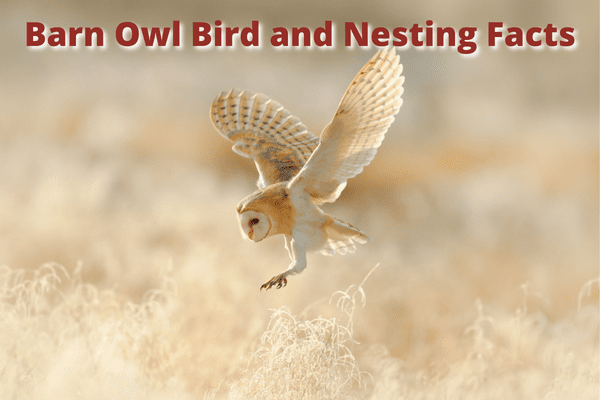Contents
- Barn owl facts
- Barn owl: how-to identify
- Where You’ll See A Barn Owl
- Barn owl diet
- Barn owl nesting
- Barn owl behavior
- How-to attract barn owls
- Barn owl threats
- Barn owl fun & interesting facts
- Barn owl FAQ
- What does a Barn owl sound like?
- What is a Barn owl’s habitat?
- What is a Barn owl’s lifespan?
- Is it rare to see a Barn owl?
- Why is it called a Barn owl?
- Are Barn owls friendly to humans?
- Why does a Barn owl screech at night?
- Where to put a Barn owl box?
- Where are Barn owl ears?
- When is Barn owl breeding season?
- When do Barn owls nest?
- When do Barn owls leave the nest?
- How to build a Barn owl box
- How much does a Barn owl eat per day?
- What are Barn owl pellets?
- What is the spiritual meaning of a Barn owl?
- Barn owl related species in this family
The barn owl is a well-known bird. In fact, out of every bird species, the barn owl is the most widespread of them all. It can be found in just about every place except for desert and polar regions, the majority of Indonesia, parts of the Pacific islands, and north of the Himalayas in Asia.
Another name for this bird species is the common barn owl. They gave it this name to help differentiate it from varying species within its family.
And that’s just the tip of the iceberg.
Today, we’ll learn much more about this owl and other interesting facts and identifying features of these birds. The discussion will include the following topics:
- Identifying characteristics of a barn owl
- most common places to find them
- migratory patterns
- nesting habits
- behaviors
- and much more
Care to learn more about this magnificent creature? Read on to discover everything you ever needed to know about the barn owl and more.
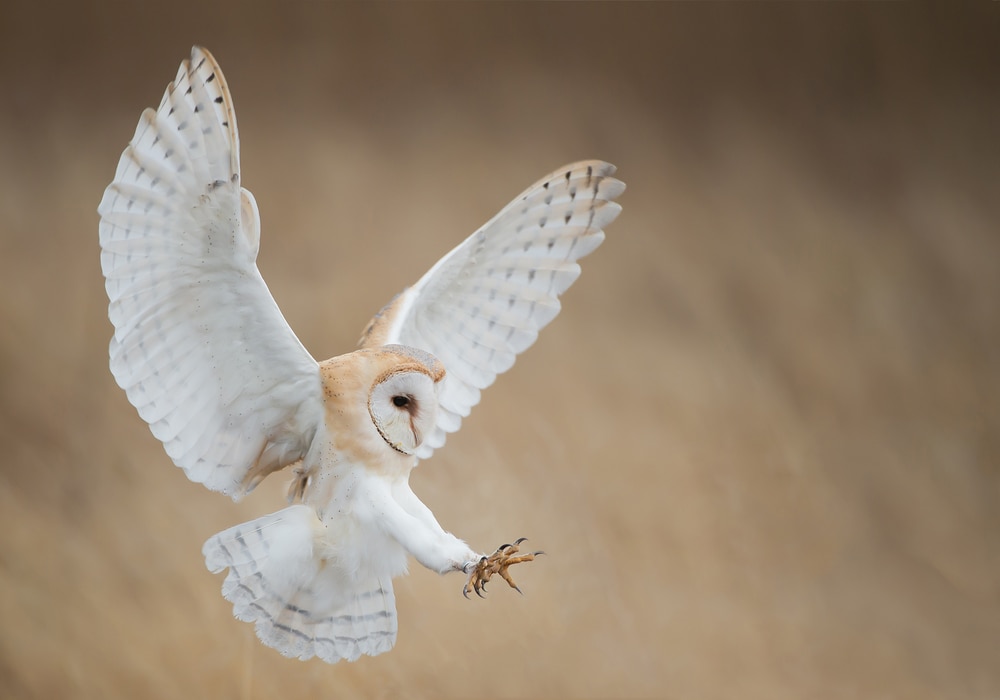
Barn owl facts
- Common Name: Barn Owl
- Scientific Name: Tylo alba
- Scientific Family: Tytonidae
- Life Span: 4 years
- Size: 13.0 to 15.0 inches
- Wingspan: 31.0 to 37.0 inches
- Weight: 14.1 to 24.7 oz
- Conservation status: Least Concern
Barn owl: how-to identify
To identify this owl, please note that it has a pale-colored body that’s typically medium-sized. It has long wings as well, but its tail is squarish and on the short side.
Across varying subspecies of barn owls, this bird has considerable size differences. On average, a typical barn owl is usually 13 to 15 inches in length with 31 to 37 inches in wingspan.
For the most part, when this owl lives on a small island, it’s usually lighter and smaller than typical owls. It also has dangling feathered legs and it follows an undulating flight pattern, which are very distinguishing features of the barn owl.
Combine this with its paleface and black heart-shaped eyes, which give this unusual yet attractive bird a very distinctive appearance. Some consider the face of this owl to look like a flat mask containing oblique and oversized black eye slits.
Related article: 10 Best Live Owl Cams Online: 24/7 Live Streaming
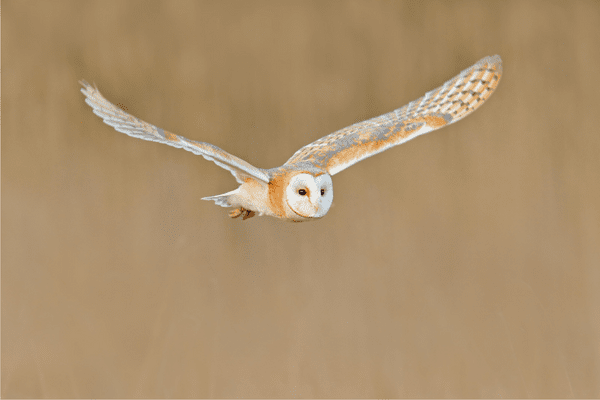
Differences Between Male & Female
The female of the species typically has gray features that are on the slightly darker side combined with rich brown coloring.
Male owls of this species, on the other hand, typically have light gray features that are typically mixed with light buff or white feathers.
Lastly, if there isn’t any barring on the tail, this certainly means that the owl is male.
Differences In Summer Plumage vs Winter Plumage
This bird has very soft plumage but it tends to remain the same during summer or winter seasons, so there aren’t any changes to mention.
Where You’ll See A Barn Owl
These owls are the most widespread bird out of every potential species. In fact, many consider it one of the most multicultural birds of all time.
With that said, these birds are found regularly in Australia, Southeast Asia, Europe, Africa, South America, North America, and India.
The only continent that isn’t known as a home to these creatures is Antarctica. Although, you have a difficult time seeing them because it’s rare since they tend to function at night in the dark.
These birds have a very distinct call as well. But it’s something that you’ll hardly ever hear out in the wild. It is possible to see or hear them in captivity, but that’s usually the extent of it.
Related article: 7 Simple & Proven Ways To Attract Owls To Your Yard
Barn owl bird migration
This owl is a non-migratory bird. It’s also the kind of bird that is found in many different areas throughout the world. In North America, you’ll find a plentiful supply of these nocturnal birds in southern New England, Michigan, North Dakota, and British Columbia. They also spend their lives in South America as well.
Besides the Americas, they are found in Asia, Australia, Africa, and Europe.
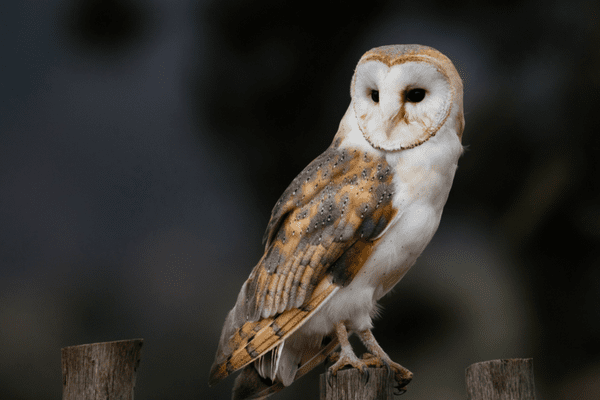
Barn owl diet
As a nocturnal hunter, this owl is known for eating small mammals that it can easily find in the heat of the night. It regularly eats rats, voles, shrews, and mice. It’s also known as a creature that will consume the flesh of other birds.
They maintain a very keen sense of smell. This ability combined with its ability to see in low light makes it very capable of catching tiny prey. Plus, they are known for having very soft feathers. This light plumage makes it easy for these sneaky creatures to silently get behind pray without them knowing they are even being stalked.
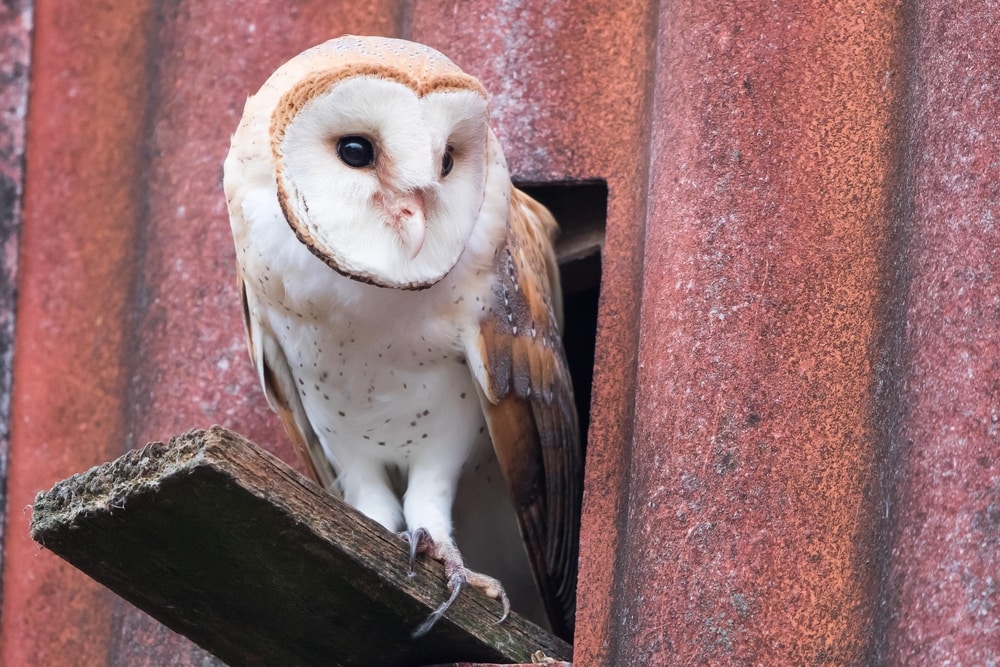
Barn owl nesting
- Clutch Size: 5-7 eggs
- # of Broods: 1 brood
- Incubation Period: 29-34 days
- Nestling Period: 55-70 days
- Egg Description: Dull White
As far as investing is concerned, this bird will nest in nest boxes, buildings, cliff cavities, and hollow trees. Unlike many other species, this owl will not typically tend to build a true nest. They usually find a bunch of debris around their nesting area and form it into a depression.
While nesting, the female barn owl can lay anywhere from 2-11 eggs at the least or most. But on average, the female is known to lay roughly 5-7 eggs per incubation mating session. After the female lays her eggs, she will typically incubate them for 29-34 days.
On average, young owls begin flying after being born for 60 days. After making their first flight, young owls of this species tend to return to the nest for a few weeks before leaving the nest entirely.
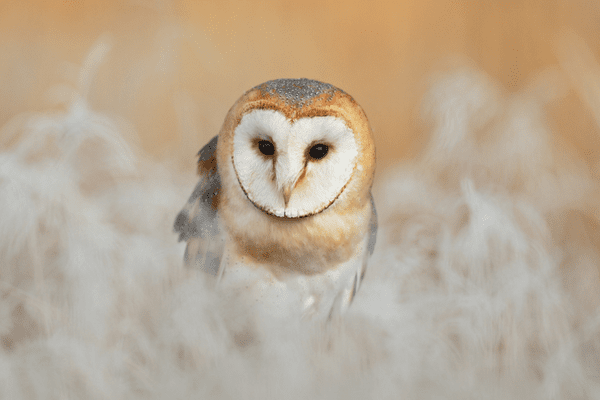
Barn owl behavior
In the case of this owl being threatened, it initiates a very specific wing spreading and swaying behavior. The bird will spread its wings as wide as possible while swaying its head moving it back and forth. Even more interesting, this nocturnal creature will occasionally fall onto its back and kick with its feet toward the potential threat in an effort to protect itself.
These creatures also have the ability to locate prey at night very easily using sight and sound. Their phenomenal low light vision makes it easy to spot prey in the middle of the night, which isn’t always possible for other bird species. They also have incredible hearing, which makes it simple to locate different types of prey by sound, which helps keep these birds safe and well-fed.
Related article: Owl Life Expectancy: How Long Do They Live?
How-to attract barn owls
Since these owls are pretty much everywhere besides really hot or really cold climates, it’s pretty easy to attract them to your home. Although they only come out at night, it isn’t always easy to see them.
One of the best methods for attracting these creatures is to install nesting boxes throughout your backyard. Make sure it’s set up in a secure location throughout your home. Many owls like to sleep in hollow cavities within trees, but other owl species including barn owls actually like to spend time in manufactured nesting boxes.
When installing a nesting box, make sure to place it 10-12 feet off the ground. Keep it in an area where they’ll have no problem hunting for small animals including rats, mice, voles, and shrews.
Instead of pruning large tree branches, keep them intact. The owls like to perch on them at night, which creates a beautiful opportunity for you to see them in their natural habitat.
Create a more appealing hunting ground by mowing the lawn less. Provide birdbaths because these owls tend to drink and bathe in large baths, and leave the flood lights on timers. A well-lit backyard isn’t going to be appealing to night stalking owls of this kind.
Barn owl threats
This owl has a conservation status that is considered Least Concern. According to Wikipedia, this means, “A Least Concern species is a species that has been categorized by the International Union for Conservation of Nature (IUCN) as evaluated as not being a focus of species conservation because the specific species is still plentiful in the wild.”
Barn owl fun & interesting facts
- This owl has soft fringe-edged feathers. They are considered silent feathers and they do not make a swishing sound as the bird moves through the air.
- These creatures are relatively small in body size. They are typically around the size of a smaller cat, yet they only weigh about a pound.
- They have tremendous hearing and night vision. This makes it easy for them to capture prey in the dark of night.
- They are known for making screeching and hissing noises. These noises are eerie and kind of scary when you hear them at night.
- These owls have incredibly short lifespans. Roughly 70% of these creatures die within their first year of life.
- They have incredibly voracious appetites. They can eat more than their entire weight in rats and mice in one evening.
- These birds like to live in man-made structures including church towels, barns, water tanks, and silos.
Barn owl FAQ
What does a Barn owl sound like?
The barn owl is different from many other owls because it doesn’t actually hoot. Instead, it actually creates a very harsh and scary sound. For two seconds long, the barn owl will let loose a long and harsh scream.
Males mostly scream this way more often than not. But females will also give the call from time to time, but they do so infrequently.
There is also a version of this call that is a lot softer and has a wavering tone. They call it a purring call, which the males like to use when getting the attention of females. They use this call to let the females know that it is time to begin expecting the nest site.
Females will also use the purring call from time to time. They use it to contact the males in an effort to beg for food.
When intruders are present, barn owls also make a hissing noise that lasts for 3-4 seconds. They make this hissing sound to scare predators or intruders on the verge of disturbing their nest.
What is a Barn owl’s habitat?
The barn owl tends to keep open spaces and clearings. They also like to live in cities, farmland, and forest edges.
Why do they prefer wide-open spaces? They like the open areas because it makes it easy for them to hunt on the land.
Typically, you’ll find a barn owl roosting in the crevices in cliffs, on riverbanks, or within tree cavities. It also shouldn’t surprise you that barn owls also prefer to roost in buildings including barns.
What is a Barn owl’s lifespan?
Typically speaking, the average lifespan of an adult barn owl living in the wild is roughly 2-4 years. Although, in captivity, the longevity of a British barn owl on record is 15 years old. And other barn owls have been known to live for as long as 34 years in captivity.
More often than not though, barn owls usually have a very short lifespan and they are known to die young.
Is it rare to see a Barn owl?
You may be wondering if it’s rare to see a barn owl. Unfortunately, they are very uncommon to see and it’s often difficult to spot them.
Why? They are nocturnal creatures so they spend the majority of their life hidden within cavities or crevices or barns or other large structures during the day. They only come out at night, which makes it very difficult to see them and it’s quite an uncommon occurrence.
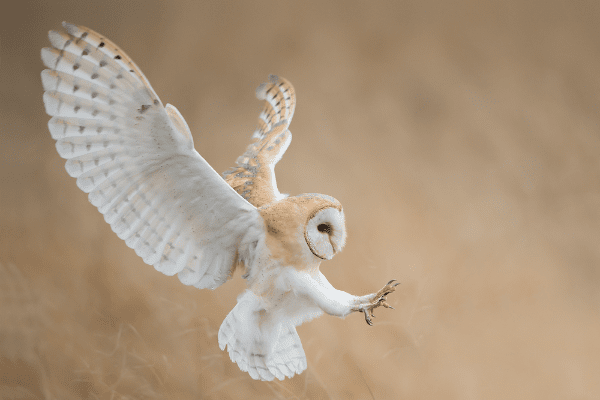
Why is it called a Barn owl?
Why is it called a barn owl forgiving record, it’s that easy to find that he
Are Barn owls friendly to humans?
It shouldn’t surprise anyone to learn that a barn owl has gotten its name because it likes to choose to nest within a barn. Besides the barn itself, it will also choose to live in other man-made structures, and crevices on cliff sides, and it will even nest within hay bales within a group.
Why does a Barn owl screech at night?
Barn owls definitely tend to screech at night and make a blood-curdling shriek, but they do so for good reason. More often than not, the owl is attempting to communicate with other owls. The barn owl will make its loud scream in an effort to warn other owls that a potential threat is in the area.
Where to put a Barn owl box?
According to barnowltrust.org.uk, the best place to put a barn owl nest box is actually inside a building. “If there is a large building that a barn owl can enter at 3+ meters above the ground then this is almost certainly the best place to put a new barn owl nest box.”
They go on to tell us that it costs less to put one inside of a building, it’s much easier to erect, it will last a lot longer, and putting it inside the building provides the barn owls with extra shelter, which is certainly a good idea.
Where are Barn owl ears?
Amazingly, the opening holes for a barn owl’s ears are hidden directly behind their eyes. The barn owl has a heart-shaped face with feathers around the edge. These feathers even act like outer ears and focus and trap the sound.
One of their ears is higher than the others. And while the barn owl is flying, it will capture sounds in its left ear from below while capturing sounds in its right ear from above. The two different types of years make it possible for barn owls to pinpoint their prey and figure out precisely where it’s hiding by sound.
When is Barn owl breeding season?
Different from many other owls, the breeding season of the barred owl lasts particularly long. During their long breeding season, it will start in the very early days of March and typically lasts all the way into the end of October.
More often than not, the barn owl will spend time nesting more than once during a particular year. They do not construct a nest for themselves but will hide within bales of hay by burrowing inside or they’ll take over a new or abandoned empty nest box.
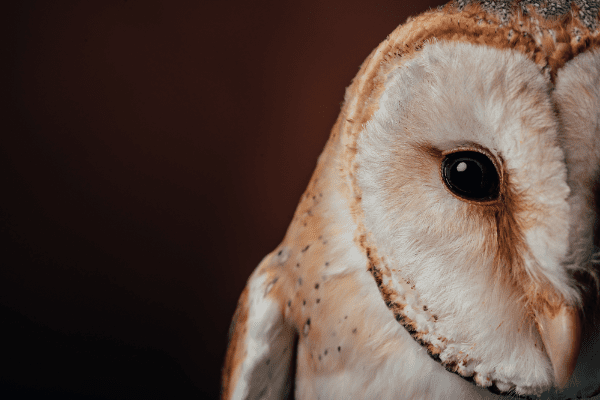
When do Barn owls nest?
As mentioned earlier, North American barn owls maintain a longer breeding season than just about every other owl in North America. Nesting typically takes place between March-June, but the season could last much longer going all the way into October.
As an example, in 2019 a nest of barn owls was discovered in the month of October in the vicinity of State College, Pennsylvania. The nest had 5 hatchlings inside, but only three of them survived.
When do Barn owls leave the nest?
Barn owl hatchlings tend to grow quite rapidly. This is especially true during their first month of being alive. These chicks even end up heavier than their adult counterparts by the time they fled. Fledging typically takes place within 50-55 days after they have hatched.
How to build a Barn owl box
The best way to build a barn owl box is to use the resources available to you on the web. Some websites sell plans that make it very easy to build a barn owl box from scratch. They will share tool requirements, required materials, drawings and plans, and other valuable resources.
On the other hand, there are barn owl boxes available for you to purchase on the Internet. It will give you all of the materials and drawings needed to put the nest box together at home without any difficulty whatsoever. I prefer using premade nesting boxes because it’s a lot easier than designing a brand-new barn owl box from scratch.
Just remember, when hanging the barn owl box, take the following into consideration:
- Have the barn owl box face the area in which the owl will hunt
- When mounting the box, please do so in an open and conspicuous entrance
- Avoid mounting a barn owl nesting box in a forested habitat and do not have it face the woods
- You’ll have a much better chance of attracting a barn owl if you mount it within an open habitat
- Avoid the afternoon heat by mounting the nest box with the entrance facing east or north
How much does a Barn owl eat per day?
Believe it or not, farmers love having barn owls on their farms because they use them to keep the rodent population at bay and under control. They prefer to have owls on hand instead of using poisons to kill the rodents.
While it’s difficult to pinpoint the exact amount of food that a barn owl eats during the day, many scientists have estimated that it will eat roughly 1 rat per day. If an entire barn owl family is living on a farm including a male, female, and two hatchlings, this could equate to the entire family eating 3 or 4 rats per day.
What are Barn owl pellets?
Did you know that barn owls actually swallow their prey whole? They do not have the ability to digest bone and hair, so they have to eventually regurgitate these parts of their prey. It’s the regurgitated bones and undigested hair that form the barn owl pellets.
Other interesting facts about barn owl pellets include:
- Once a barn owl eats its prey, it typically takes this creature roughly 6 hours or more to finally produce a pellet
- Once hunting is completed each night, the barn owl typically regurgitates 1-2 pellets
- The regurgitated pellet is usually about the size of the thumb of an adult male. When it is regurgitated and fresh and is usually black in color
- Barn owl pellets typically contain the remains of 4-5 different smaller mammals
- Dissecting barn owl pellets makes it possible to discover exactly what the owl was eating
What is the spiritual meaning of a Barn owl?
From a spiritual standpoint, the barn owl definitely possesses symbolic meaning. The main reason why the barn owl possesses the symbolism that I am about to share is because of its ability to hunt at night in the dark. It can see when there isn’t any light present
Because of this unique ability, the barn owl typically symbolizes intuition, mystery, productivity, and listening. If you consider the barn owl your spirit animal, you’ll come to realize that it is a highly intuitive creature that can provide insight and wisdom when it’s needed the most.
- North American Barn Owl
- Central American Barn Owl
- Bahamian Barn Owl
- Cuban Barn Owl
- Subandean Barn Owl
- Colombian Barn Owl
- Hellmayr’s Barn Owl
- Brazilian Barn Owl
- Tortugan Barn Owl
- Dominican Barn Owl
- St. Lucia Barn Owl
- Curaçao Barn Owl
- Galapagos Barn Owl
- British Barn Owl
- European Barn Owl
- Madeiran Barn Owl
- Ernest’s Barn Owl
- Canary Island Barn Owl
- Cape Verde Barn Owl
- West African Barn Owl
- SAO Thome Barn Owl
- African Barn Owl
- Madagascan Barn Owl
- Erlanger’s Barn Owl
- Indian Barn Owl
- Burmese Barn Owl
- Andaman Barn Owl
- Sumban Barn Owl
- Kisar Barn Owl
- Savu Barn Owl
- New Guinea Barn Owl
- Boaing Island Barn Owl
- Santa Cruz Barn Owl
- New Caledonia Barn Owl
- Australian Barn Owl

